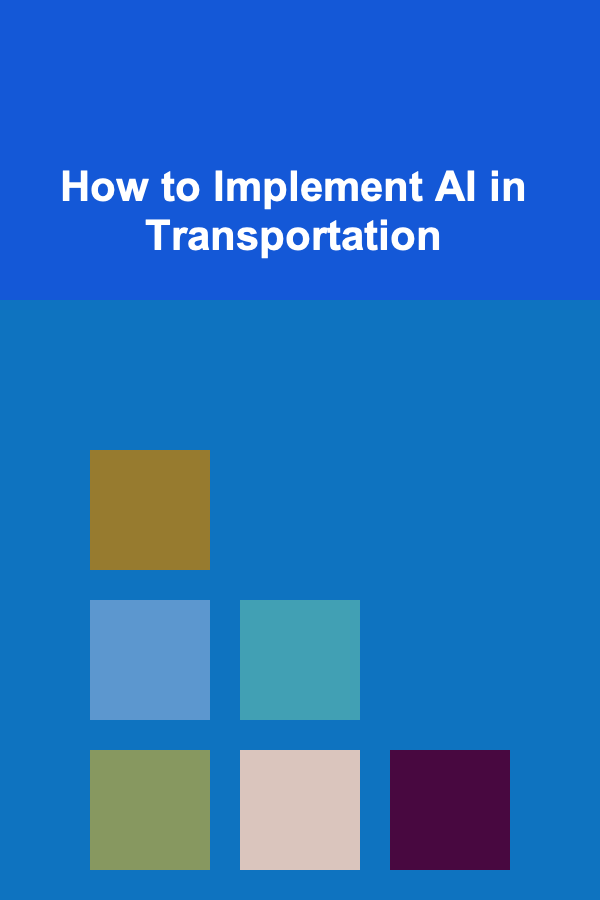
How to Implement AI in Transportation
ebook include PDF & Audio bundle (Micro Guide)
$12.99$9.99
Limited Time Offer! Order within the next:

Artificial Intelligence (AI) has become one of the most transformative technologies of the 21st century. Its potential to revolutionize various industries is vast, and one of the most exciting areas of AI implementation is in transportation. The transportation sector, including road, air, rail, and maritime travel, is undergoing a massive transformation due to AI's ability to improve efficiency, safety, and sustainability. In this article, we will explore how AI can be effectively implemented in transportation, focusing on the challenges, opportunities, and practical approaches to integrating AI into this critical sector.
The Role of AI in Modern Transportation
Transportation systems are the backbone of economies worldwide, enabling the movement of goods and people across vast distances. However, these systems face numerous challenges, including congestion, accidents, inefficiency, and environmental impact. AI presents a significant opportunity to address these challenges by optimizing operations, enhancing safety, and reducing carbon emissions.
AI technologies such as machine learning, computer vision, natural language processing, and robotics can be applied to various aspects of transportation, from autonomous vehicles and smart traffic management to predictive maintenance and route optimization. The integration of AI into transportation systems can make them smarter, more responsive, and more sustainable.
Key AI Applications in Transportation
- Autonomous Vehicles: Self-driving cars, trucks, and drones represent one of the most significant advancements in AI-driven transportation. These vehicles use AI algorithms to interpret sensor data, make real-time decisions, and navigate roads or airways without human intervention.
- Traffic Management: AI can be used to optimize traffic flow in cities by analyzing real-time data from sensors and cameras. AI algorithms can adjust traffic signals, predict congestion, and suggest alternative routes to reduce delays.
- Predictive Maintenance: AI can be used to monitor the health of vehicles and infrastructure, predicting when maintenance is required before a failure occurs. This can reduce downtime and improve the reliability of transportation systems.
- Route Optimization: AI-powered systems can analyze historical traffic data, weather patterns, and real-time information to recommend the most efficient routes for vehicles, reducing fuel consumption and travel time.
- Fleet Management: AI can help manage fleets of vehicles by optimizing scheduling, dispatching, and routing, ensuring that goods are delivered on time and vehicles are utilized efficiently.
Challenges of Implementing AI in Transportation
While the potential benefits of AI in transportation are significant, the implementation of AI in this sector is not without its challenges. These challenges must be addressed to ensure the successful integration of AI technologies.
2.1. Regulatory and Ethical Issues
One of the primary barriers to implementing AI in transportation is the regulatory landscape. Self-driving vehicles, for example, raise a host of legal and ethical questions, such as liability in the event of an accident, privacy concerns related to data collection, and the need for clear standards and certifications.
Governments and regulatory bodies will need to work closely with AI developers, transportation companies, and other stakeholders to create frameworks that ensure the safe and ethical deployment of AI technologies. These frameworks should address issues like data privacy, cybersecurity, and the ethical implications of AI decision-making.
2.2. Data Privacy and Security
AI systems rely heavily on data to make informed decisions, and transportation systems generate vast amounts of data from sensors, GPS, cameras, and other sources. This data can include sensitive information, such as a person's location or vehicle identification number, raising concerns about data privacy and security.
To address these concerns, AI systems in transportation must adhere to strict data protection standards, ensuring that personal data is anonymized, encrypted, and used responsibly. Additionally, robust cybersecurity measures must be in place to protect transportation systems from malicious attacks.
2.3. Infrastructure Compatibility
Many transportation systems are built on legacy infrastructure that may not be compatible with modern AI technologies. For example, existing road networks may lack the sensors or communication systems needed to support autonomous vehicles or smart traffic management systems.
Upgrading infrastructure to support AI technologies can be expensive and time-consuming. Governments and private companies will need to invest in modernizing infrastructure to ensure that AI can be effectively integrated into existing transportation networks.
2.4. Public Perception and Acceptance
The adoption of AI in transportation also faces challenges related to public perception and acceptance. Many people are hesitant about the safety and reliability of autonomous vehicles, while others may be concerned about job displacement due to automation.
To gain public trust, it is essential for AI developers and transportation companies to demonstrate the safety and reliability of AI-powered systems. Public education campaigns, transparency in testing and development, and the gradual introduction of AI technologies can help address these concerns.
Opportunities for AI in Transportation
Despite these challenges, the opportunities presented by AI in transportation are vast. Here are some of the key areas where AI can make a significant impact.
3.1. Improving Safety
Safety is a primary concern in transportation, and AI has the potential to significantly reduce accidents and fatalities. Autonomous vehicles, for example, can be equipped with sensors and cameras to detect obstacles, pedestrians, and other vehicles, reducing the likelihood of accidents caused by human error.
AI can also be used to improve safety in other areas of transportation, such as air travel and rail systems. In aviation, AI can be used for predictive maintenance, ensuring that aircraft are in optimal condition and reducing the risk of mechanical failures. In rail systems, AI can help monitor track conditions and predict potential issues before they cause accidents.
3.2. Enhancing Efficiency and Reducing Congestion
AI can optimize transportation systems to improve efficiency and reduce congestion. For example, AI-powered traffic management systems can analyze real-time traffic data and adjust traffic signals to optimize the flow of vehicles, reducing congestion and travel times.
Autonomous vehicles can also reduce traffic congestion by using AI to communicate with other vehicles and adjust their speeds to maintain smooth traffic flow. Additionally, AI-powered ride-sharing services can optimize vehicle routes and reduce the number of cars on the road, further alleviating congestion.
3.3. Environmental Sustainability
AI can contribute to the sustainability of transportation systems by reducing fuel consumption, emissions, and waste. For example, AI can optimize routes for delivery trucks, reducing fuel usage and lowering carbon emissions. Autonomous vehicles, particularly electric vehicles, can also reduce emissions by operating more efficiently than traditional vehicles.
AI can also be used to improve public transportation systems, making them more efficient and reducing the need for private car ownership. This can lead to a reduction in the overall number of vehicles on the road, decreasing traffic congestion and lowering the environmental impact of transportation.
3.4. Cost Reduction
The implementation of AI can help transportation companies reduce costs by improving operational efficiency. For example, AI can be used to optimize vehicle maintenance schedules, reducing downtime and repair costs. Fleet management systems powered by AI can also optimize routing and scheduling, reducing fuel consumption and labor costs.
Moreover, autonomous vehicles have the potential to reduce the need for human drivers, lowering labor costs in sectors such as trucking and ride-sharing. While there are concerns about job displacement, the long-term cost savings and efficiency improvements can provide significant economic benefits.
Steps to Implement AI in Transportation
Implementing AI in transportation requires a strategic approach to ensure that the technology is deployed effectively. Here are some key steps for organizations looking to integrate AI into their transportation systems.
4.1. Identify Use Cases
The first step in implementing AI in transportation is to identify the most relevant use cases. These can vary depending on the type of transportation system, whether it's road, air, rail, or maritime. Some potential use cases include:
- Autonomous vehicles for freight and passenger transport
- AI-powered traffic management systems
- Predictive maintenance for vehicles and infrastructure
- Route optimization for logistics and delivery services
- Smart public transportation systems
By focusing on the most critical areas where AI can provide the greatest impact, organizations can prioritize their efforts and resources effectively.
4.2. Invest in Data Collection and Infrastructure
AI systems rely on large amounts of high-quality data to function effectively. Therefore, it is essential to invest in data collection systems, such as sensors, cameras, GPS devices, and IoT technologies, to gather real-time data from transportation networks.
Additionally, infrastructure upgrades may be necessary to support AI technologies. For example, autonomous vehicles require well-maintained roads, smart traffic lights, and vehicle-to-infrastructure communication systems. Investing in these technologies will be crucial to the successful implementation of AI.
4.3. Collaborate with Stakeholders
The implementation of AI in transportation involves a wide range of stakeholders, including governments, transportation companies, technology developers, and regulatory bodies. Collaboration between these groups is essential to ensure the successful deployment of AI technologies.
Governments can help by creating clear regulatory frameworks that encourage innovation while ensuring safety and ethical standards. Transportation companies and technology developers can work together to create AI solutions tailored to the specific needs of the transportation sector.
4.4. Focus on Safety and Testing
Safety is paramount when it comes to transportation, especially in the case of autonomous vehicles. Before deploying AI-powered systems at scale, rigorous testing and validation are necessary to ensure that they meet safety standards.
Testing should involve real-world scenarios, simulations, and pilot programs to assess the performance and reliability of AI systems. It is also essential to ensure that AI systems are designed with fail-safe mechanisms in place to prevent accidents in case of system malfunctions.
4.5. Educate the Public
To gain public acceptance of AI technologies in transportation, it is essential to educate the public about the benefits and safety of these systems. Public education campaigns, transparency in testing and development, and clear communication about how AI will impact transportation can help alleviate concerns and foster trust.
Conclusion
The implementation of AI in transportation has the potential to transform the sector by improving safety, efficiency, sustainability, and cost-effectiveness. While there are challenges to overcome, including regulatory issues, infrastructure compatibility, and public perception, the opportunities for AI in transportation are vast.
By identifying key use cases, investing in data and infrastructure, collaborating with stakeholders, focusing on safety and testing, and educating the public, transportation companies and governments can successfully integrate AI into their systems. The future of transportation is intelligent, autonomous, and data-driven, and AI will be at the heart of this revolution.

How to Keep Your Pet Safe During the Holidays
Read More
How to Plan for Your Child's Education Expenses
Read More
How to Use Feedback to Improve Your Time Management Skills
Read More
How To Give a Stand-Up Comedy Set
Read More
Mastering a Strong Online Presence for Print-on-Demand (POD)
Read MoreHow to Use a Home Maintenance Expense Tracker for Tax Deductions
Read MoreOther Products

How to Keep Your Pet Safe During the Holidays
Read More
How to Plan for Your Child's Education Expenses
Read More
How to Use Feedback to Improve Your Time Management Skills
Read More
How To Give a Stand-Up Comedy Set
Read More